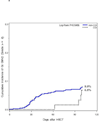Clostridium difficile infection after allogeneic hematopoietic stem cell transplant: strain diversity and outcomes associated with NAP1/027
- PMID: 24973628
- PMCID: PMC4852556
- DOI: 10.1016/j.bbmt.2014.06.025
Clostridium difficile infection after allogeneic hematopoietic stem cell transplant: strain diversity and outcomes associated with NAP1/027
Abstract
Allogeneic hematopoietic stem cell transplantation (HSCT) recipients are at high risk for developing Clostridium difficile infection (CDI). We studied the incidence, risk factors, NAP1/027 prevalence, and clinical outcomes, including acute lower gastrointestinal graft-versus-host disease (GI GVHD), associated with early CDI in this population. A retrospective review was conducted of patients who underwent allogeneic HSCT at Memorial Sloan Kettering Cancer Center from January 1, 2005 to September 30, 2010. Early CDI was defined as infection occurring from day -10 to day +40 from stem cell infusion. Among 793 patients who received allogeneic HSCTs, early CDI occurred in 11.9%; 56% cases were between day -5 and day +5. Overall incidence was 25.2 cases/10,000 at-risk days. There was a high prevalence of NAP1/027 strains during peak incidence (61% in 2008). NAP1/027 was the most common strain in both adult and pediatric cases (24% and 23%, respectively). CDI was clinically mild, including those due to NAP1/027. Metronidazole was the primary treatment for 91 of 94 patients, 7 of 8 cases refractory to metronidazole had no response to vancomycin, and none was due to NAP1/027. Relapse of CDI was common (31%). The cumulative incidence of GI GVHD in patients with and without early CDI was 6.8% and 8%, respectively (P = .5). Most cases of CDI occurred during conditioning or immediately after transplant. Despite high prevalence of NAP1/027, we found only mild disease. Most patients were treated successfully with metronidazole, irrespective of NAP1/027 status. There was no significant association between early CDI and subsequent development of GI GVHD. This study demonstrates the high incidence of CDI early after allogeneic HSCT with wide diversity among infecting strains. Despite the high prevalence of NAP1/027, the disease is mild but relapses are common. No association was found between CDI and subsequent development of GI GVHD.
Keywords: Allogeneic hematopoietic stem cell transplantation; Clostridium difficile infection; Immunocompromised host; NAP1/027 strain.
Copyright © 2014 American Society for Blood and Marrow Transplantation. Published by Elsevier Inc. All rights reserved.
Conflict of interest statement
Figures





References
-
- Alonso CD, Treadway SB, Hanna DB, Huff CA, Neofytos D, Carroll KC, et al. Epidemiology and outcomes of Clostridium difficile infections in hematopoietic stem cell transplant recipients. Clinical infectious diseases : an official publication of the Infectious Diseases Society of America. 2012 Apr;54(8):1053–1063. - PMC - PubMed
-
- Kamboj M, Son C, Cantu S, Chemaly RF, Dickman J, Dubberke E, et al. Hospital-onset Clostridium difficile infection rates in persons with cancer or hematopoietic stem cell transplant: a C3IC network report. Infection control and hospital epidemiology : the official journal of the Society of Hospital Epidemiologists of America. 2012 Nov;33(11):1162–1165. - PMC - PubMed
-
- Loo VG, Poirier L, Miller MA, Oughton M, Libman MD, Michaud S, et al. A predominantly clonal multi-institutional outbreak of Clostridium difficile-associated diarrhea with high morbidity and mortality. The New England journal of medicine. 2005 Dec 8;353(23):2442–2449. - PubMed
-
- Samore MH, DeGirolami PC, Tlucko A, Lichtenberg DA, Melvin ZA, Karchmer AW. Clostridium difficile colonization and diarrhea at a tertiary care hospital. Clinical infectious diseases : an official publication of the Infectious Diseases Society of America. 1994 Feb;18(2):181–187. - PubMed
Publication types
MeSH terms
Substances
Grants and funding
LinkOut - more resources
Full Text Sources
Other Literature Sources

